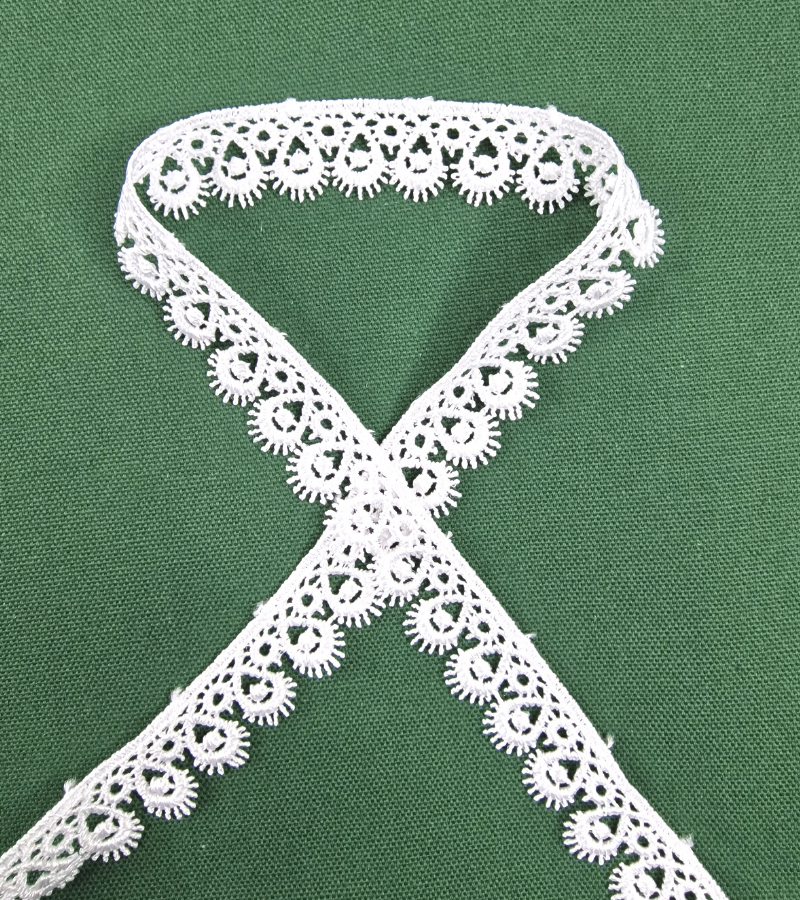Description
GUIPURE
Very elegant and decorative guipure, often used by the textile industry to decorate curtains, bedding and other products. Guipure is a type of material – once traditionally made using the block method and now by machine.
GUIPURE LACE – CHARACTERISTICS
What distinguishes guipure from embroidery is the presence of large and irregular meshes. The appropriate weave of threads creates a fabric. On the market you will also find small guipure patterns in the form of applications, e.g. for clothing or other textiles. Guipure also has a characteristic, convex structure. Guipure lace is a very difficult and time-consuming decoration to make. Today, hardly anyone produces it by hand, but it is still a desirable element of decorations. When it comes to patterns, guipure fabrics usually use floral motifs, ornaments and geometry. In the past, guipure was made of cotton, linen and silk, today rather of polyester with the addition of elastane.
THE HISTORY OF GUIPURE
The technique of producing guipure fabrics dates back to the 16th century and comes from Flanders. It was there that guipure lace and fabrics first began to be weaved. The technique of bobbin lace, which is used to create guipure, allows the production of various types of materials, such as antulage, blond, binche or guipure. It was the most fashionable in the 19th and 20th centuries, today it is much less popular.
TYPES OF GUIPURE
Guipure fabrics may differ in the yarn from which they were made and in width. Today we can find both narrow, ready-to-sew guipure laces in the form of narrow decorative strips on one or both sides, as well as much wider fabrics, from which textiles or clothing are sewn. When it comes to colors, guipure lace is usually produced in white or ecru. However, it happens that manufacturers dye guipure and thus obtain it in many different colors. Of course, guipure fabrics can be different in terms of patterns that we find on them. The most common are floral, floral and geometric ones.
APPLICATION OF GUIPURE
Currently, the most important application of guipure fabrics is the production of curtains for the kitchen, living room or bedroom, lambrequins or jealous curtains. Curtains with guipure or jealous guipure will be a nice decoration of any interior. Lace can appear on a different surface of the curtain, thanks to which we will certainly find a model tailored to our tastes. Where else can we find plasterboard materials? Certainly, guipure appears on evening and wedding dresses. Its decorative and elegant character is perfect for such occasions. However, guipure lace can also be found on other items of clothing, such as shirts, collars, hair ornaments. Guipure lace is perfect for rejuvenating or changing clothes, home decorations as well as scrapbooking. Its use has no limits in the imagination.
GWIPIURA
Bardzo elegancka i dekoracyjna gipiura, często wykorzystywana przez przemysł tekstylny do ozdabiania zasłon, pościeli i innych produktów. Gipiura to rodzaj materiału – kiedyś tradycyjnie wytwarzany metodą blokową, a obecnie maszynowo.
KORONKA GIPIUROWA – CHARAKTERYSTYKA
To, co odróżnia gipiurę od haftu, to obecność dużych i nieregularnych oczek. Odpowiedni splot nici tworzy tkaninę. Na rynku znajdziesz również drobne wzory gipiurowe w formie aplikacji np. na odzież czy inne tekstylia. Gipiura ma również charakterystyczną, wypukłą strukturę. Koronka gipiurowa to bardzo trudna i czasochłonna dekoracja do wykonania. Dziś mało kto wykonuje go ręcznie, ale nadal jest to pożądany element dekoracji. Jeśli chodzi o wzory, tkaniny gipiurowe najczęściej wykorzystują motywy roślinne, ornamenty i geometrię. Dawniej gipiurę wykonywano z bawełny, lnu i jedwabiu, dziś raczej z poliestru z dodatkiem elastanu.
HISTORIA GHIPURE
Technika produkcji tkanin gipiurowych sięga XVI wieku i wywodzi się z Flandrii. To właśnie tam po raz pierwszy zaczęto tkać gipiurowe koronki i tkaniny. Technika koronki klockowej, która służy do tworzenia gipiury, pozwala na produkcję różnego rodzaju materiałów, takich jak antulage, blond, binche czy gipiura. Był najmodniejszy w XIX i XX wieku, dziś jest znacznie mniej popularny.
RODZAJE GHIURY
Tkaniny gipiurowe mogą różnić się przędzą, z której zostały wykonane oraz szerokością. Dziś możemy znaleźć zarówno wąskie, gotowe do szycia koronki gipiurowe w postaci wąskich ozdobnych pasków po jednej lub obu stronach, jak i znacznie szersze tkaniny, z których szyte są tekstylia czy odzież. Jeśli chodzi o kolorystykę, koronka gipiurowa produkowana jest najczęściej w kolorze białym lub ecru. Zdarza się jednak, że producenci barwią gipiurę i w ten sposób uzyskują ją w wielu różnych kolorach. Oczywiście tkaniny gipiurowe mogą różnić się pod względem wzorów, które na nich znajdziemy. Najczęściej spotykane są kwiatowe, kwiatowe i geometryczne.
ZASTOSOWANIE GIPURY
Obecnie najważniejszym zastosowaniem tkanin gipiurowych jest produkcja zasłon do kuchni, salonu czy sypialni, lambrekinów czy zasłon zazdrosnych. Zasłony z gipiury lub gipiury zazdrosnej będą ładną ozdobą każdego wnętrza. Koronka może pojawić się na innej powierzchni zasłony, dzięki czemu z pewnością znajdziemy model dopasowany do naszych gustów. Gdzie jeszcze możemy znaleźć materiały do płyt gipsowo-kartonowych? Z pewnością gipiura pojawia się na sukniach wieczorowych i ślubnych. Jego dekoracyjny i elegancki charakter doskonale sprawdza się na takie okazje. Jednak koronki gipiurowe można znaleźć również na innych elementach garderoby, takich jak koszule, kołnierzyki, ozdoby do włosów. Koronka gipiurowa doskonale nadaje się do odmładzania lub zmiany ubrań, dekoracji wnętrz, a także scrapbookingu. Jego zastosowanie nie ma granic w wyobraźni.
INFORMATION
I am a seller but also a buyer, and I know how important the colors of the products you use for your projects are. Therefore, be aware that the colors of the products in the pictures may slightly differ from reality. It depends on the model, resolution and individual settings of your monitor. If you have concerns, it is always better to make sure and ask the seller about the details of the product before buying.






























